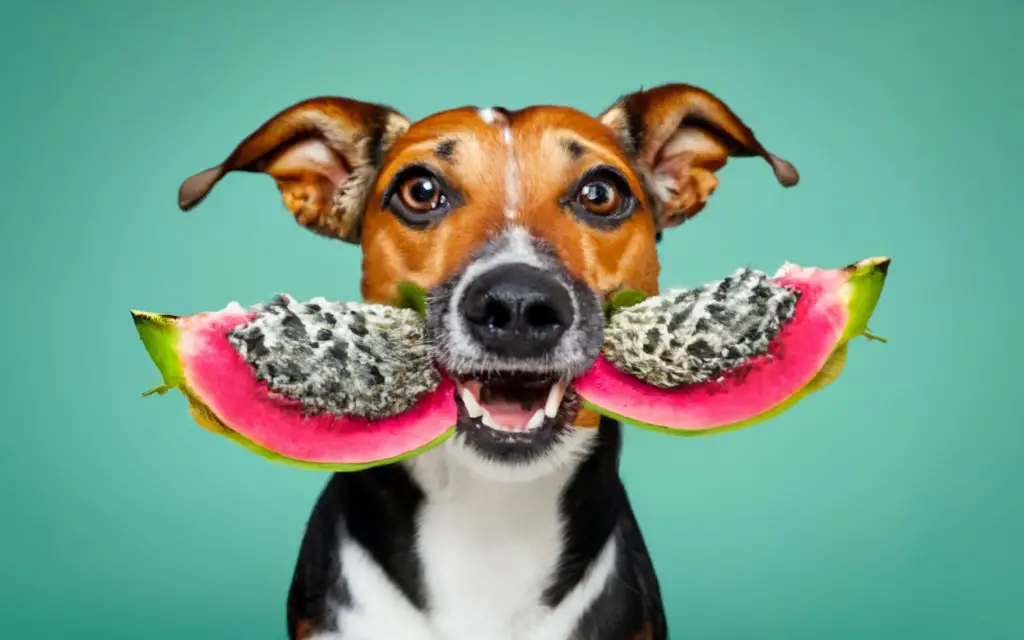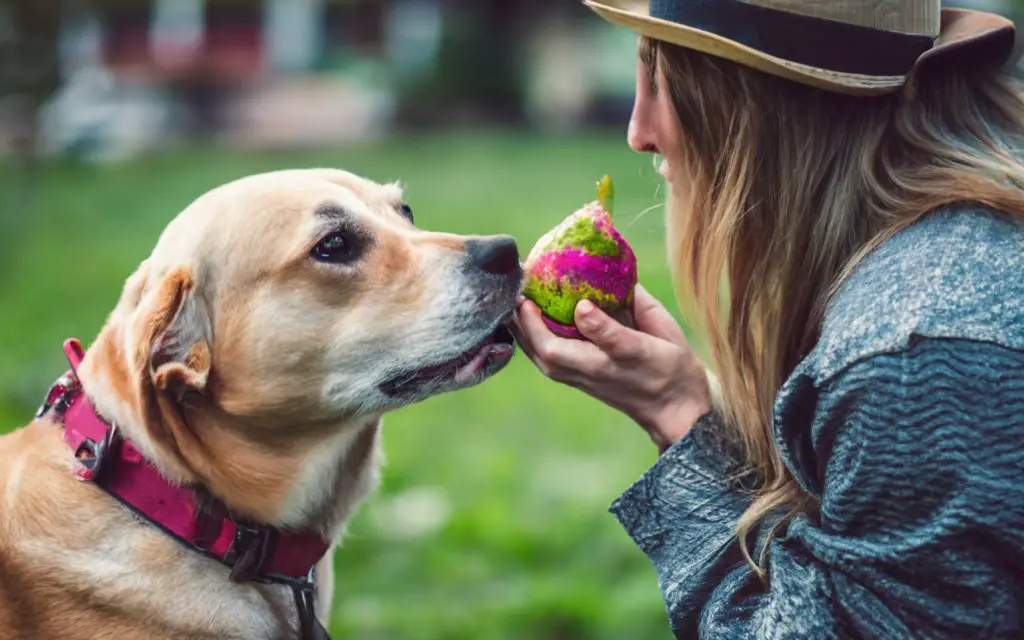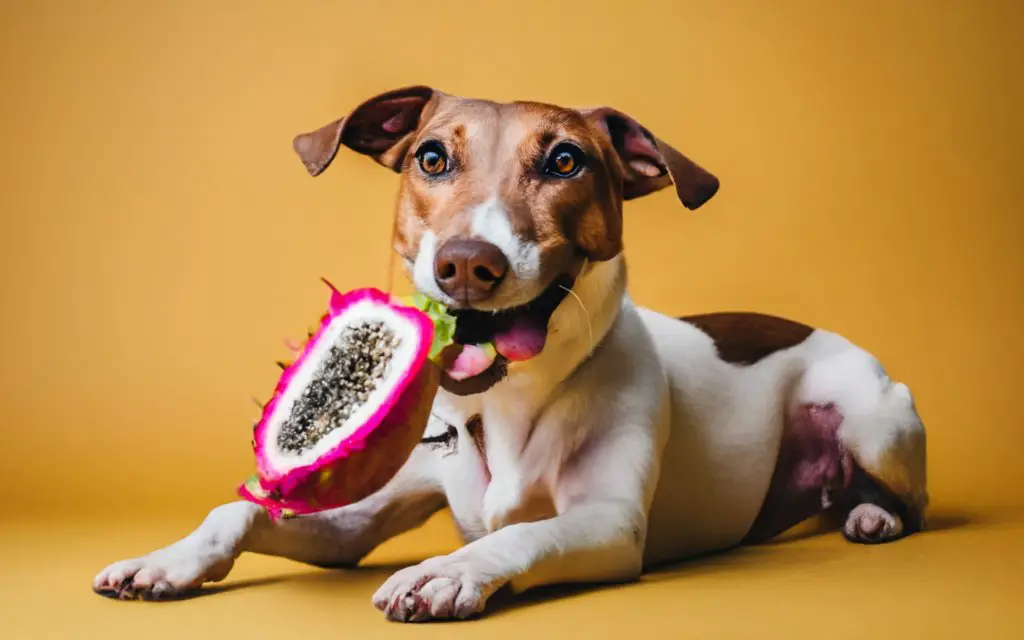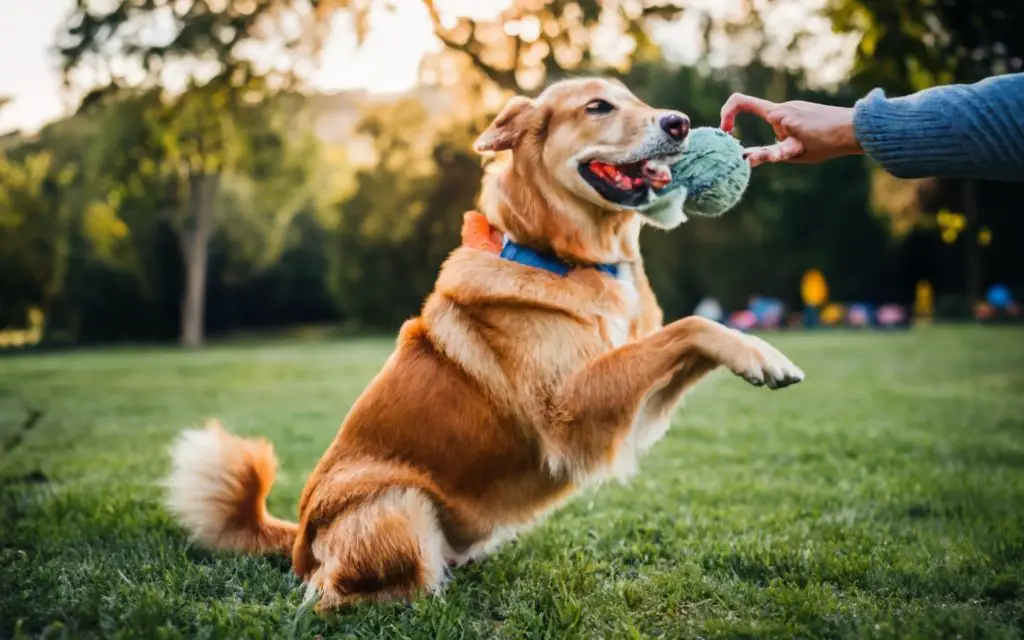Ever caught your pup eyeing your dragon fruit with longing? You’re not alone! The question “Can dogs eat dragon fruit?” pops up in many dog-loving heads. Worry not, fellow pet parents, because we’re about to peel back the layers (pun intended!) on this vibrant fruit and its furry-friend-friendliness. Buckle up for a fact-packed journey into the world of dragon fruit and canine snacking!
What is Dragon Fruit?

Imagine a fruit that looks like a hot pink grenade studded with black caviar. Meet the dragon fruit, a tropical sensation with a taste as unique as its looks. Hailing from Central America, this beauty (also known as pitaya) comes in two main types: white-fleshed and red/pink-fleshed. Both boast a taste like a kiwi-pear tango, making them a hit with humans and, as we’ll discover, potentially with our four-legged companions.
Can Dogs Eat Dragon Fruit?

Music to a dog’s ears (and yours, after this blog!): Canines can absolutely dig into dragon fruit, and the good news doesn’t stop there. This tropical treat is brimming with antioxidants, fiber, and vitamin C, all working their magic to boost your pup’s immune system, aid digestion, and keep their coat shiny and healthy. But hold your horses (or leashes!). Dragon fruit seeds can be tough on doggy tummies, and like any new food, moderation is key to avoid upset stomachs. When in doubt, your vet is the ultimate snack-approval buddy.
Unleashing the Dragon Fruit: A Treat Powerhouse with Caveats (for Your Pup’s Sake!)
Gone are the days of your pup eyeing your dragon fruit with puppy-dog longing. This vibrant tropical treat, exploding with antioxidants and prebiotic fiber, can be a healthy and delicious reward for well-behaved pups. But before you whip out the fruit knife, let’s peel back the layers on dragon fruit’s potential paw-some benefits and some friendly reminders for responsible snacking.
Antioxidant All-Star:
Picture tiny shields protecting your pup’s cells from nasty free radicals. That’s the magic of dragon fruit’s antioxidant powerhouses like beta-carotene and vitamin C. It’s like a superhero smoothie for their immune system, keeping them fighting fit and ready for adventure.
Digestive Buddy:
Prebiotic fiber in dragon fruit acts like a cheerleader for your pup’s gut bacteria. It helps their digestive system run smoothly, keeping things balanced and comfortable (read: no tummy grumbles!).
Low-Calorie Celebration:
Skip the guilt with this light and refreshing snack. Dragon fruit is perfect for pups watching their weight or simply enjoying a treat without the calorie overload. Just remember, moderation is key, even with good things!
A Word of Caution:
While dragon fruit’s sugar content is generally low, it’s still present. For diabetic pups or those prone to digestive sensitivities, keep portions small and monitor for any upset stomachs. If in doubt, your vet is always the ultimate snack-approval buddy!
What Happens When a Dog Eats Dragon Fruit?
So, your pup gobbles down a dragon fruit chunk – now what? Reactions vary like dog park antics! Some pups become taste-bud adventurers, relishing the sweet-kiwi-pear vibe and begging for more. Others shrug and stick to their kibble routine. Watch for tail wags, lip licks, and fruit-fiend frenzy as signs your dog digs this new treat. But keep a detective eye out for upset stomach clues like poop changes or tummy grumbles. Remember, your furry friend is unique – what’s a dragon fruit delight for one might be a digestive dud for another.
How to Serve Dragon Fruit to Dog:

Turning your dragon fruit into a pup-approved snack requires chef-worthy prep. Grab a ripe one with a vibrant, even complexion. Slice it open like a treasure chest and scoop out the flesh, leaving those black caviar-looking seeds behind (they’re tough on doggy tummies!). Dice the juicy goodness into bite-sized pieces fit for your four-legged pal. Remember, dragon fruit should be a snacking sidecar, not the main course. Aim for less than 10% of your dog’s daily calories to avoid overloading their system. Think of an occasional treat, not a daily supplement. And like introducing any new dish, watch your pup closely and check with your vet if anything seems off.
Remember, every pup is unique, so tailor portions based on their size and activity level. A general rule of thumb is around one bite-sized piece per pound of body weight. For a playful pug weighing 20 pounds, that translates to roughly 2-3 chunks of dragon fruit goodness. For a majestic Alaskan Malamute tipping the scales at 100 pounds, you can bump it up to 5-6 pieces. Just remember, these are just guidelines, and it’s always best to start small and watch for any reactions.
| Feature | Details |
| Benefits | Antioxidants, digestive fiber, low calories |
| Risks | High sugar content (monitor for loose stools) |
| Serving Sizes | 1 bite-sized piece per pound of body weight (adjust based on size and activity level) |
| Important Note | Always consult your vet before introducing new foods |
Can Cats Eat Dragon Fruit?

Curious about your feline friend and this pink powerhouse? Fear not, dragon fruit isn’t on the kitty no-no list. But remember, cats are meat-loving marvels, with their dietary needs met by the purrfect prey. While this fruit boasts human-friendly nutrients, cat bodies aren’t wired to absorb them as efficiently. So, if your furball snags a bite, it’s generally harmless, but large portions might trigger digestive hiccups like tummy grumbles or even an unwelcome volcanic eruption. Keep it to tiny tastes and avoid making it a regular meow-nu. And as always, consult your vet before introducing any new nibbles to your cat’s routine.
Conclusion:

We’ve peeled back the layers on dragon fruit and pups, diving into its health benefits and potential pitfalls. It’s a safe snack, served seed-free and in moderation. Remember, every dog is a unique foodie, so watch for tummy tales and tailor treats accordingly. We hope this guide has been your pawsome companion on the journey to dragon fruit delights! Share your doggy dragon fruit experiences and questions in the comments below – after all, sharing is caring (and delicious!). Happy snacking!







Pingback: Can Dogs Eat Almond Butter? A Comprehensive Guide -